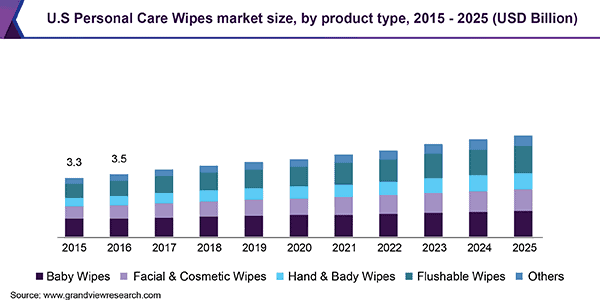Wipes have so many uses. But no matter how you prefer to use them, they will always need proper disposal.
Today, we find more reasons to keep using wipes as it appears to be a new phenomenon.
Yet, wipes generate more than half of the sewer blockage reports.
Even though some manufacturers claim that their products are flushable and biodegradable, it is not what happens in most cases.
Many consumers are left to wonder, “can you put biodegradable wipes down the toilet?“
Never flush biodegradable wipes down the toilet even when the product label says you can.
Regardless of the manufacturer’s assurances, not all wipes that come with the ‘biodegradable’ and ‘flushable’ label should go down the toilet.
The disintegration process is not immediate, and the wipes can reach the sewer system before it is complete.
In addition, some materials may take up to 500 years before they decompose.
Besides rayon fibers and cotton, wet wipes also have plastic resins. These are:
- Polyester
- Polythene
- Polypropylene
Read more : Organic Baby Carrier Reviews: Healthy And Safe Baby
The Benefits of Using Biodegradable Wipes
Biodegradable wipes are suitable for personal and surface cleaning.
The intention around the design is to make them as hygienic as possible to flush them down the toilet after use.
New methods include biodegradable wipes that can disintegrate when soaked in water.
The advantages of such a wet wipe are multifold. They include:
- Wet wipes are more comfortable compared to dry toilet paper.
- Biodegradable wipes clean better and have more sanitary uses than toilet paper.
- Most biodegradable wipes are flushable
- Wet wipes are easy to use
- Biodegradable wipes leave no mess in the bathroom bin.
- There is no lingering odor since you can flush them away
- Some biodegradable wipes are scented and will leave you feeling refreshed.
The Cost of Convenience
We are living in an era where everyone is obsessed with convenience.
The price to pay weighs heavy as the environmental impact that comes with the use of disposable wipes grows rife.
For instance, when wipes find their way to surrounding water bodies, marine animals mistake them for food.
When humans consume some of these marine animals, microplastics find a way back into the food chain.
The long-term consequence of this dangerous cycle is devastating to our bodies.

The impact of biodegradable wipes on homes
If you look at national figures, you will grasp how dire flushing wipes down the toilet hurts us all.
The problem is that it brings rise to other inconveniences, and homeowners incur costs trying to correct the action.
When you flush wipes down your toilet, they join forces with other matter present in the sewer lines. These are mostly
- Fats
- Oil
- Grease
When these elements solidify, they form nasty lumps in the sewer lines making the passage become narrow.
Flushing wipes in your toilet will quickly cause a blockage, and the sewer contents will flow back and up your bathroom and sinks.
When this happens, you will pay a hefty cost to unblock your drain, not forget to clean and replace damaged items.
Read Our Latest Post:
- Are Shoes Recycled Or Trash?
- Is Sewer Water Recycled?
- Are Pistachio Shells Biodegradable?
- Can You Recycle AdBlue Containers?
- Can You Recycle Wagamama Containers?
How ‘Biodegradable’ Wipes impacts the environment
The advantage of flushable wipes is that they solve the immediate problem of convenient disposal.
Because wipes can pass through your home’s plumbing system and into the sewer lines, it doesn’t mean the problem is solved.

Despite biodegradable wipes being convenient for you, they are problematic to our environment regardless of how they end up there.
- Thrown away. Wet wipes contain synthetic fiber that makes them non-recyclable and compostable. When wet wipes reach the landfills, we expect them to start disintegrating immediately. But because of the present synthetic fiber, they will form a large percentage of non-biodegradable waste.
- Littered. It is regrettable that not all trash will end up in the garbage can. Some people who use wet wipes on the go will toss them by the roadside. Eventually, the final destination is the water bodies that constitute marine life like oceans, rivers, lakes, and dams.
Wet wipes are fatal to all marine life as they settle on the stomach once consumed. Because they are indigestible, animals die from starvation.
- Flushed. When manufacturers label wet wipes as “flushable,” it makes them more attractive than toilet paper. Imagine how getting that squeaky-clean wipe will make you feel.
However, many environmental enthusiasts feel that the idea of flushable and biodegradable wipes is a distant illusion.
Flushable wipes don’t break down like toilet paper when saturated in water. It mixes with other congeals and blocks your drain and sewer lines.
- Looming Health Hazard. Despite wet wipes having a negative impact on the environment, they are also health hazards waiting to happen. Some wet wipes contain various chemicals that tend to enhance their sanitation abilities. Such chemicals can be toxic and may react with your skin. Other wipes are scented and have preservatives to make them last longer.
The chemicals can be irritable and lead to excruciating rashes and skin inflammation.
The Truth About Biodegradable and Flushable Wipes?
Nonwoven cloths are sparking new controversies from consumers and attract constant lawsuits from city authorities.
The dependence on wet wipes leads to massive reports of faulty sewer plant machinery emanating from clogs every day.
Unfortunately, the majority of biodegradable wet wipes you will find in the market never disintegrate fast enough.
The more durable the wipe is, the longer it will take to break down, eventually leading to a clog in your sewer lines.
The Controversy that Surrounds Biodegradable Wipes
The primary disagreement here is between what is flushable and what is not.
Recent squabbles also apportion blame towards product labeling. INDA, which stands for the Association of the Nonwoven Fabrics Industry, has some innovative guidelines.
In 2017, wastewater professionals put wet wipes manufacturers under fire.
The reason was that a majority of the manufacturers fail to include “do not flush” labels on their packaging of non-biodegradable products.
According to INDA, a majority of flushable wipes will cause little or no harm in sewers.
Further research also shows that a paltry one percent of all sewer blockages result from biodegradable or flushable wipes.
Frequently Asked Questions
Are there ‘flushable’ wipes that are flushable?
Some companies claim to have flushable wipes. It is also true that when you flush biodegradable wipes, you will see them break down in the water.
While these kinds are better than toilet paper, some flushable wipes are too strong and thick.
Eventually, long-term use will lead to the clogging of your sewer system.
How will I identify biodegradable wipes?
You can’t tell from the first glance which wipes are biodegradable or not.
The only reliable method is to check for the manufacturer labels. The obligation to label wipes that contain synthetic fibers falls at the mercy of manufacturers.
Suffice to say, they rarely exercise this duty.
Consumers are often confused when it comes to making a sustainable and environmental-friendly choice.
Are all biodegradable wet wipes suitable for flushing down the toilet?
No! Biodegradable refers to a product that can disintegrate naturally by microorganisms.
Flushable wipes are not biodegradable as the primary composition is short and numerous cellulosic fibers.
Compared to toilet paper, the disintegration process takes place immediately, and it gets soaked in water.
The biodegradation follows soon after courtesy of natural microorganisms.
How long will it take for biodegradable wipes containing cellulose fibers to disintegrate fully?
There is no general answer since numerous factors influence the outcome.
For a biological degradation process to happen, the wet wipes must be free of all fossil-based synthetic fibers.
It will guarantee that no microplastics find their way into our environment.
Cellulosic fibers come from renewable extracts like leaves, wood, and plants.
Cellulosic fibers from wood extracts will decompose when exposed to familiar elements like soil and warm temperatures.
If wood-based fibers somehow find themselves in water bodies like oceans, rivers, and lakes, they will still degrade.
In freshwater and at temperatures that exceed 21 degrees Celsius, it will take six weeks.
In saltwater, the degradation process is much faster and will take four weeks at temperatures of 30 degrees Celsius.
Unfortunately, most wet wipes come laced with lotions and fragrances that might affect the decomposition process.
Wrap Up
All fingers are pointing at non-flushable wipes as the sinister cause for the majority clogging up of sewers.
As we look for solutions, it is emerging that consumer education is a quick fix to this recurrent problem.
If you prefer using wet wipes instead of toilet paper, always dispose of them in a bin.
Though it can be tempting to flush it down your toilet, always avoid doing so.
The ultimate risk of harming marine life is real. Constant plumbing bills should also motivate you to desist from flushing biodegradable wet wipes down.
Today, the wet wipe industry is on an evolutionary path that should involve consumers and manufacturers alike.
What we need to learn is what we can or can’t flush down the toilet. Also, we should develop a healthy culture of throwing all forms of wet wipes in bins.


